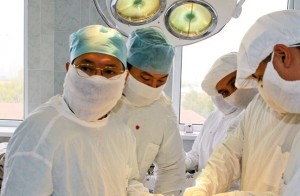 SEMEY – The new men’s health centre in Semey will partner with the Dzhanbursynov Scientific Centre for Urology. The decision was made by specialists from both of these organisations during a meeting of the Republican Action School of Men’s Health hosted by In Vitro, a private clinic.
SEMEY – The new men’s health centre in Semey will partner with the Dzhanbursynov Scientific Centre for Urology. The decision was made by specialists from both of these organisations during a meeting of the Republican Action School of Men’s Health hosted by In Vitro, a private clinic.
“During the meeting, we conducted free medical exams for 150 citizens who have urology related problems,” Chief Urologist of Kazakhstan Myrzakan Alchinbayev said. “In addition, we examined the personnel of one of the military units and delivered lectures to local colleagues who specialise in urology and andrology.”
According to scientists, today prostatitis is not just a disease, it is a social problem. According to international studies, benign prostatic hyperplasia is one of the most common diseases among older men. It affects more than 50 percent of men under the age of 50 and almost 90 percent of men under 80.
“In the results of men’s reproductive health screening studies across 14 regions of Kazakhstan, signs of mild erectile dysfunction were discovered in 53 percent of cases. Men with a moderate level of ED constituted 28 percent of those studied and seven percent of men studied suffered from severe ED,” Alchinbayev said.
The Dzhanbursynov Scientific Urology Centre has hosted the Action School of Men’s Health across Kazakhstan for many years and actively promotes opening medical centres that deal with the problem. As explained by Galia Zhuasbayeva, deputy head of the East Kazakhstan Regional Healthcare Department, they have already prepped personnel and allocated space for the Semey centre.
In the past year, SCU specialists held similar events in Shymkent, Ust-Kamenogorsk, Karaganda and Almaty. It is difficult to overestimate their importance, because according to statistics, male life expectancy is 10 percent lower than that of women. By the age of 75, cancer deaths among men are two times higher than among women, cases of coronary heart disease occur at rates three times more often among men than women and diabetes is six times more frequent. This situation is compounded by the fact that men visit doctors three times less often than women. This is why the early detection of disease amongst men is so low.

